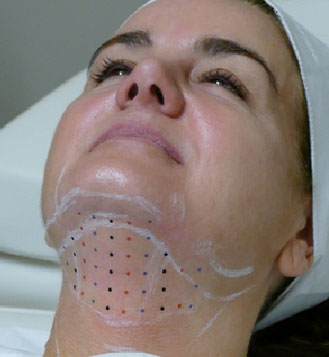
Few accomplishments are as rewarding as waking up in the morning and hitting your target weight. You've worked hard to drop those unwanted pounds all year long, and you deserve a huge round of applause for what you've accomplished. However, if you're like many men and women, getting the sleek, sculpted body you crave is easier said than done. You've got pockets of unwanted fat around your abdomen, thighs, chin, and other areas - fat that just won't go away, despite diet and exercise.
Wouldn't it be nice to just freeze that fat away and forget all about your love handles?
At Southern Cosmetic Laser, our new, revolutionary fat-freezing treatment can help you achieve the toned look you've been dreaming of. That's right - we're talking about literally freezing the unwanted fat off your problem areas without invasive surgeries or extended downtime.
This amazing treatment is called CoolSculpting, and it's the world's leading non-invasive fat reduction procedure. It's specifically designed for people already at their desired weight who want to push past that plateau for real body sculpting results. If you're tired of seeing that excess belly fat, saggy skin, or double chin, CoolSculpting is the procedure for you. Southern Cosmetic Laser offers a wide range of the newest technologies to target fat reduction, skin tightening, facial and body remodeling, body toning, and cellulite reduction.

Our Services
Services Area

What is CoolSculpting?

CoolSculpting is an FDA-approved procedure that has undeniable results. With CoolSculpting, you can permanently get rid of your muffin top, fat around your flanks, and more, all from the comfort and convenience of the Southern Cosmetic Laser office.
Technically known as cryolipolysis, CoolSculpting has the ability to reduce the number of fat cells in targeted areas between 20 and 25%. This unique technology uses controlled cooling to freeze and eliminate fat with minimal recovery time. No needles, no scalpels, no liposuction. Just real results provided by a licensed, experienced professional.
While CoolSculpting helps eliminate fat cells in your body, it doesn't harm the surrounding skin and muscles. Instead, it treats fat that is directly under the skin, also called subcutaneous fat. Since CoolSculpting doesn't target visceral fat deposits, this treatment works best for men and women who are approaching or already at their desired weight.
CoolSculpting is approved by the FDA to help reduce fat in the following areas:
- Flanks
- Outer Thighs
- Upper Arms
- Inner Thighs
- Chin
- Back
- Belly and Abdomen
How Does CoolSculpting Work?

CoolSculpting results are noticeable, proven, and long-lasting, helping you look your best and feel great from every angle. This exciting procedure works because fat cells freeze at higher temps than other tissues. As such, CoolSculpting delivers controlled, targeted cooling to do away with unwanted fat underneath your skin. These fat cells are essentially frozen or crystallized and eventually die. With time, your body will process that fat and will eliminate the dead cells, leaving behind a more sculpted physique.
Here are some quick CoolSculpting facts at a glance, so you have a better idea of why this fat cell elimination treatment is so popular:
- There is no prep time required for CoolSculpting from Southern Cosmetic Laser.
- Patients can expect some very minor discomfort during the procedure. Many patients report no discomfort at all.
- There is little-to-no downtime needed after your CoolSculpting procedure is complete.
- It may take up to 12-16 weeks to see your final results.
- This procedure eliminates fat permanently!

Southern Cosmetic Laser's CoolSculpting Procedure

Our CoolSculpting procedure is crafted around your comfort, with one-on-one attention in a relaxing atmosphere. It all starts with a detailed assessment, which you will complete prior to your treatment. This assessment will help us better understand your goals and desires, so we can freeze away the stubborn fat from the areas that matter most.
Typical CoolSculpting appointments take about an hour per area, though that time varies with each patient. Because our CoolSculpting applicators use a vacuum system to help with placement, you may feel a pulling sensation in the targeted area. Once placement is complete, we get to work on freezing your fat.
Before treatment, your skin is prepped with an alcohol wipe. A gel pad is then placed on your treatment area to help protect your skin. From there, a cold sensation is delivered through our applicators, which are designed for specific body parts.
Because there is no sedation involved with CoolSculpting, we encourage you to kick back, relax, and watch a little TV. If you prefer, you can also read or use your phone to check your favorite social media sites. Our friendly, experienced CoolSculpting technicians strive to keep you as comfy as possible during this quick treatment. When it's over, you can resume normal activities as soon as you like - there's no recovery or downtime to worry about!


Top CoolSculpting Treatment Areas

CoolSculpting procedures are perhaps best known for eliminating stubborn belly fat, giving the patient a desirable, contoured tummy. However, this treatment is also very effective on other areas of your body:
CoolSculpting for Your Double Chin
While neck fat usually goes hand-in-hand with weight gain, symptoms like double chins can appear even if you're not overweight. CoolSculpting helps solve neck fat problems by eliminating fat cells in the area below your chin, giving you a slim, youthful appearance.

CoolSculpting for Unwanted Belly Fat
Many men and women begin CoolSculpting treatments to destroy fat around the abdomen or midsection. CoolSculpting does so by freezing stubborn subcutaneous fat in the abdominal region, resulting in a trimmed-up tummy. Remember, CoolSculpting does not treat visceral fat, or the fatty tissue surrounding the organs in your abdomen.

CoolSculpting for Your Back
Back fat is a serious problem for many people in the U.S. This includes the upper back (where fat rolls over the bra), the mid-back (near the waist), and the lower back (where fat bulges over the beltline). Back fat can be hard to tone, but with CoolSculpting from Southern Cosmetic Laser in Awendaw, it's more than possible.

CoolSculpting for Your Upper Arms
When it comes to stubborn fat, your upper arms are often the most difficult areas to treat. If you are constantly trying to hide your upper arms from friends and family, CoolSculpting is an excellent option to help overcome your insecurity.

CoolSculpting for Your Love Handles
Sometimes called saddlebags or flanks, love handles are the flabby areas that protrude from your hips. Love handles are often caused by fat retention over long periods of time. They can appear very pronounced in tight clothing, leading to feelings of embarrassment. Common factors that contribute to love handles are age, slow metabolism, hormones, and diets high in sugars and fats. With Southern Cosmetic Laser's CoolSculpting, patients leave behind stubborn love handles, helping them achieve a slimmer, more fit appearance.

CoolSculpting for Your Thighs
If you are in good shape but suffer from chafing or discomfort due to fatty thighs, your solution could be at Southern Cosmetic Laser. Our technicians can help freeze away inner thigh fat, so you feel proud to wear skirts, shorts, and bikinis.


Questions About CoolSculpting? We've Got Answers
Q: Does CoolSculpting really work?
A: Yes! Southern Cosmetic Laser wouldn't be one of the most trusted providers of the treatment if it didn't work. According to recent statistics, CoolSculpting treatments can reduce fat reduction by as much as 25% in the affected area. Contact our office today for your initial consultation, where our team will advise you on how many treatments you need to meet your goals.
Q: How much does CoolSculpting cost?
A: Pricing varies depending on the areas you focus on and how many sessions you need in order to reach your goals. Our team will craft a custom treatment plan specific to you during your initial CoolSculpting consultation.
Q: How quickly will I see results?
A: Many patients can see results as soon as three weeks after their first CoolSculpting procedure in Awendaw. As your body continues to dispose of crystallized fat cells, you can see even more changes with time.
Q: Does CoolSculpting eliminate cellulite?
A: CoolSculpting is designed for fat reduction. However, it may help contribute to cellulite reduction in specific treatment areas. There are currently no FDA clearances for cellulite reduction with CoolSculpting. However, our office offers incredible treatments like Inmode Evolve to reduce the appearance of cellulite and trim, tighten, and tone your skin.
Q: Why should I choose Southern Cosmetic Laser for CoolSculpting in Awendaw?
A: Southern Cosmetic Laser is a CoolSculpting certified practice and has completed advanced training at the CoolSculpting University. With a highly-trained staff of medical professionals, we're one of the leading providers of CoolSculpting in South Carolina. We know that peace of mind is precious these days. That's why we're committed to you and your body contouring transformation every step of the way.
Popular Treatments That Complement CoolSculpting

We are a full-service practice offering Medical Aesthetics and Cosmetic Dermatology services. As such, Southern Cosmetic Laser has several innovative treatments that complement your CoolSculpting procedure. Whether you're looking to tighten up that turkey neck or say goodbye to cellulite, we've got a custom treatment option waiting for you.


Cellulite Treatment with Sentient Sculpt
Southern Cosmetic Laser is Awendaw's first medical aesthetics practice to offer Sentient Sculpt. This exciting new product reduces fat, remodels skin tissue, and regenerates skin collagen, leaving your skin tight and smooth.
Using microwave technology, Sentient Sculpt uses up to 80% of the energy generated to penetrate fat under your skin. This process destroys fat cells and the fibrous bands that cause dimples, or cellulite. The remaining 20% of energy is used on the upper layers of your skin, tightening and contracting it to improve its overall appearance.
Sentient Sculpt benefits include:
- Long-Lasting Results
- Improved Skin Laxity
- Effective Skin Tightening & Fat Reduction
- Fat Cells Permanently Destroyed
- Younger Looking Skin
- Minimal Discomfort
- Built-In Cooling for Maximum Comfort
Contact Southern Cosmetic Laser today to learn more about the benefits of Sentient Sculpt and how it can be paired with CoolSculpting treatments.

Kybella for Your Double Chin
If you're ready to kiss that double chin goodbye, Kybella could be the solution you need. Kybella is a treatment that deoxycholic acid that breaks down fat cells when injected into the treatment area. It provides noticeable results for improved chin profile.
Kybella Benefits Include:
- Permanent destruction of fat cells
- Quick treatment process
- Patients may see results in 2 to 4 treatments

Facial Remodeling with Inmode Evoke
Inmode Evoke is the first and only FDA-approved, non-invasive product for facial remodeling treatment. Evoke offers tightening and lifting for facial rejuvenation and can help you achieve a more defined neck and jawline.
The Evoke Intelligence System regulates temperature and sense impedance every millisecond, providing remarkable results. Using proven bipolar radiofrequency energy, Evoke sub-dermally remodels your facial tissue. The Evoke technology offers precise, consistent power to achieve optimal results.

Tite, Trim, & Tone with Inmode Evolve
This advanced, state-of-the-art Thermal Body Contouring Technology helps to trim, tighten, & tone your skin at the same time. Evolve's cutting-edge tech can destroy fat, reduce cellulite, and tighten skin. The result? A newfound, youthful appearance and feel. This treatment is perfect for your mommy makeover, eliminating muffin tops, sculpting abs, and addressing fat around your thighs, belly, arms, legs, hips, and knees.
Benefits of Inmode Evolve include:
- Tone and Tighten Skin
- Eliminate Fat Cells
- Reduce Crepey Skin
- Reduce Saggy Skin
- Collagen Stimulation for Improved Skin Elasticity
- Smooth Over Stubborn Fat Pockets
- Even Out and Reduce Skin Irregularities
Contact Southern Cosmetic Laser today to learn more about the benefits of Inmode Evolve and how it can be paired with CoolSculpting treatments.

Discover CoolSculpting Precision and Unlimited Beauty with Southern Cosmetic Laser
When it comes to unmatched patient care and body contouring services in Awendaw, no other practice comes close to Southern Cosmetic Laser. We pour passion into every service we offer, from non-surgical fat cell freezing to laser hair removal. If you're looking to make a change for the better this year, we're here to make your wishes a reality. Contact our office today to learn more about the stunning benefits of CoolSculpting technology. Before you know it, you'll be excited to show off that new bathing suit or bikini on the beach.
 843-277-2240
843-277-2240
Free Consultation
Latest News in Awendaw, SC
Awendaw homeowners concerned about ditch maintenance: ‘It’s a nuisance’
Caitlin Ashbaughhttps://www.live5news.com/2024/01/16/awendar-homeowners-concerned-about-ditch-maintenance/
AWENDAW, S.C. (WCSC) - Some homeowners in Awendaw say they are concerned severe weather may be bringing severe problems to their properties.Community members living on Seewee Road claim more recent storms in the Lowcountry have caused drainage issues for roadside ditches along the six-mile stretch of rural road.“My backyard is just totally covered with water,” neighbor Stephen Flagg says. “My front yard has been totally covered with water. I mean, something just needs to be done.”Flagg lives on th...
AWENDAW, S.C. (WCSC) - Some homeowners in Awendaw say they are concerned severe weather may be bringing severe problems to their properties.
Community members living on Seewee Road claim more recent storms in the Lowcountry have caused drainage issues for roadside ditches along the six-mile stretch of rural road.
“My backyard is just totally covered with water,” neighbor Stephen Flagg says. “My front yard has been totally covered with water. I mean, something just needs to be done.”
Flagg lives on the same portion of land as his grandmother, Lillie Swinton. The family has called Seewee Road home since the 1960s. They say they have noticed the problem for decades.
Both Swinton and Flagg say taking care of the ditches along the property is one thing, but they believe fixing the ditches along the wooded areas and uninhabited spaces would make a big difference.
“Anytime we have heavy rain, the water settles. The ditch drain, there’s nowhere for it to go,” Swinton says. “When summer comes, we’re going to have a lot of trouble with mosquitos, and moccasin snakes.”
At one end of Seewee Road sits the Town of Awendaw Town Hall. Town Administrator Gregory Saxton says he has heard the concerns of neighbors and relayed them to the South Carolina Department of Transportation for assistance.
Seewee Road is a state road and therefore maintained by SCDOT through work orders.
“We just want something to be done. Because after all, we’re taxpayers, just like others. We should be able to have access to things, just like the other communities,” homeowner Alberta Goodwine says. “When it’s raining, the water just settles into the ditches and overflows in the yard. It’s a nuisance.”
Goodwine worries parts of the neighborhood community have been neglected. She adds it is a problem that affects her social life and her daily routines.
“When I step out, I’ve gotta have a boot on coming off the step. To protect myself,” Goodwine says. “Put pipes or something, so drainage will go somewhere, not on my property.”
SCDOT spokesperson Ginny Jones released the following statement:
We had a crew work on ditches along Seewee Road Jan. 2-5. Last week, the crew had to work on storm recovery efforts, but we have employees back out there today. The crew will not be onsite tomorrow due to a regularly scheduled safety meeting, but they will return on Thursday and Friday, as well as next week if necessary. Our crews are digging along approximately 9,100 linear feet of roadway, so it is taking some time, but we will continue to work on it as needed.
Regarding a work order, the answer is both: A citizen may enter an online work request, or a municipality may enter a work request on behalf of a citizen. Online work requests can be submitted here: https://apps.scdot.org/mwro/
We have been in touch with the Town of Awendaw about this work. Please let us know if you need any further information.”
When asked for clarification on how uninhabited portions of the road are maintained, Jones released this response:
SCDOT maintains what is in our right of way. If the land belongs to a municipality, county, or other party, we often work with those folks to plan for maintenance, but there are a lot of different ways that can look.
Copyright 2024 WCSC. All rights reserved.
Awendaw mayor responds to concerns of overdevelopment
Conley Graysonhttps://abcnews4.com/news/local/awendaw-mayor-responds-to-concerns-of-over-development
AWENDAW, SC (WCIV) — For weeks, Awendaw residents have been expressing concerns about the potential of hundreds of new homes coming to their community."Town council has approved 822 new residences with more on the docket tonight," Awendaw resident John Cooke said. "Those residences come with a population that will at least double our current population."Read more: ...
AWENDAW, SC (WCIV) — For weeks, Awendaw residents have been expressing concerns about the potential of hundreds of new homes coming to their community.
"Town council has approved 822 new residences with more on the docket tonight," Awendaw resident John Cooke said. "Those residences come with a population that will at least double our current population."
Read more: Awendaw residents fear housing boom could threaten town's rural charm
However, Mayor Miriam Green says the population will not be doubled.
"It's not the truth," Green said. "It's not a total of 800 homes. And if it is, they still have to go through planning."
"I can't say it's 800, 9,00, or 1,000 homes because I don't know," she continued. "But in the preliminary plan, yes, it did say certain amount of homes will be built up there."
Green describes the development plans as "smart growth".
"We are following ordinance and processes of procedures and state guidelines," she said.
In response to the concerns about the development plans being too much in too little time, Green says the town has to follow guidelines and the rules.
"Just because someone comes to you and says 'This is what we want,' doesn't meant that's what the majority of the citizens of Awendaw want," the mayor said.
Residents have also expressed concerns about how new developments may affect Awendaw's roads and infrastructure.
Read more: Ten Mile Neighborhood Association challenges proposed approval of development along Seafood Road
"Last meeting, I heard emergency services people talk about the fact that they were concerned about their ability to support the town," Cooke said. "The roads, the infrastructure might not be able to support (new development). The roads that were made in the early 1950s-60s are still the ones being used today and could fail."
Green says the infrastructure, road, and traffic issues are being analyzed as part of the development plans.
"We're looking at all that stuff," the mayor said. "We have a traffic study in place, but it doesn't happen overnight."
Another concern is the septic tanks that will be used for the new development, which Green says the town is working on with the South Carolina Department of Health and Environmental Control (DHEC).
Read more: Zoning denial a 'win' for some Awendaw residents
"20 years when all these systems start to fail, you could have an ecological disaster that could affect a lot of bulls bay and the intercoastal waterways," Cooke said.
The evening of Aug. 21, the Awendaw Planning Commission reviewed the Harper Valley proposal. It was denied in a 5-1 vote.
Cooke says people who live in Awendaw are banding together in opposition and they are asking for a moratorium to slow down the development.
"It's a growing pain in Awendaw," Green said. "It's not the people that live here. It's the people that came here."
Owners of popular Awendaw BBQ spot set sights on going back to roots
Kennedy Buckhttps://abcnews4.com/news/local/owners-of-popular-awendaw-bbq-spot-set-sights-on-going-back-to-roots-eliot-middleton-and-maker-village-barbeque-charleston-county-jefferson-awards-wciv
AWENDAW, S.C. (WCIV) — For the past three years, two months, and 17 days, Middleton & Maker Village Barbeque has been providing good food for a good cause, and has provided a safe space for customers.“It’s a backyard family reunion type of effect," said Eliot Middleton, one of the co-owners of the popular business....
AWENDAW, S.C. (WCIV) — For the past three years, two months, and 17 days, Middleton & Maker Village Barbeque has been providing good food for a good cause, and has provided a safe space for customers.
“It’s a backyard family reunion type of effect," said Eliot Middleton, one of the co-owners of the popular business.
This family reunion started back in 2016 as a mobile business bringing barbeque to different areas throughout the Lowcountry, but once those wheels parked, the business began to grow.
"From that opportunity coming into this opportunity with this restaurant being available and getting this literally two days before Covid start, so it’s just been a very strong strong battle for the last four years," Middleton said.
Middleton's passion didn't stop there. After realizing transportation was hard to come by for some people, his love to help the community kicked in.
“On the Middleton side, whatever profits I get from the restaurant, it all went back into the cars and making sure I could fix and develop cars that needed," Middleton said.
Unfortunately, the popular BBQ spot, located on 5105 N HWY 17 in Awendaw, will be closing due to new development plans moving into the area. But the business is now going back to its roots.
“We’re going back mobile. It’s going to be Middleton’s Village Mobile Barbeque LLC, and we’re going to be in all of the other areas and counties, and we’re going to do more community-oriented events," Middleton said.
Despite the change in locations, the passion remains, and the village will only grow.
"And they say if you build it they will come, and that’s what we did here—we built it, and people are coming," said Charles Maker, co-owner of Middleton & Maker Village BBQ.
Middleton and Maker will also start having village field days throughout the community for people of all ages to come out, play games and get some good food.
Middleton's service to his community dates back years. In October 2020, he was recognized with the Jefferson Award after he started fixing up old cars and giving them out to people in need of reliable transportation.
Editorial: Awendaw must rise to challenge of new development
THE EDITORIAL STAFFhttps://www.postandcourier.com/opinion/editorials/editorial-awendaw-must-rise-to-challenge-of-new-development/article_ff5c8c82-cf17-11ed-874d-dfb9ed8cbe1a.html
The town of Awendaw was incorporated more than three decades ago, not so much to provide municipal services but to let residents control their planning and zoning decisions rather than relying on county government. In recent years, however, that job has become increasingly challenging because Mount Pleasant is running out of large developable sites, our region's continued growth is creating dramatic demand for more housing and Awendaw's location helps it retain much of its rural charm, wedged as it is between two environmental treasures of n...
The town of Awendaw was incorporated more than three decades ago, not so much to provide municipal services but to let residents control their planning and zoning decisions rather than relying on county government. In recent years, however, that job has become increasingly challenging because Mount Pleasant is running out of large developable sites, our region's continued growth is creating dramatic demand for more housing and Awendaw's location helps it retain much of its rural charm, wedged as it is between two environmental treasures of national significance: the Cape Romain National Wildlife Refuge and the Francis Marion National Forest.
It's more important than ever that town officials recognize the growing importance and intensity of their planning work — and rise to the occasion to protect the relaxed, rural ambiance that has defined this part of South Carolina's coast.
There are some encouraging signs.
A year ago, we lamented proposals to develop two large subdivisions, with 249 and 204 homes respectively, to be served by individual septic tanks since there are no sewer lines in the town. Those are still in the permitting stages and we hope they will be scaled back if they're built at all. They certainly underscore the need for state regulators to consider the cumulative impact of large subdivisions with dozens, even hundreds, of septic tanks that can compromise nearby waterways, as they have done along Shem and James Island creeks.
But the encouraging news is when yet another septic-tank subdivision was proposed recently, the Awendaw Planning Commission voted unanimously against Sewee Landing's 72 homes on 50 acres. At the same meeting, the commission recommended an update of the town's planned development ordinance that these subdivisions had relied on.
Awendaw Town Council could consider both the subdivision proposal and the ordinance rewrite as early as this week, and we urge council members to follow their planning commissioners' advice.
Even when a septic system is well-maintained, it can face problems if the water table is too high, and rising groundwater can carry the resulting contaminants to rivers and marshes, a problem that's expected to grow more acute as climate change pushes sea levels higher. Awendaw's proximity to the pristine Cape Romain makes it a desirable place to live, but too many septic tanks too close to the refuge (and too close to each other) could taint the very thing that makes the area an attractive place to visit and to live.
These developments don't pose a threat simply because they would rely on septic systems. They also would increase the amount of impervious surface and stormwater runoff, exacerbate habitat loss and degrade the community's rural character.
Awendaw is a small town that seems to have been pushed around at times. Its deal for a new park to be created by then-Charleston County Councilman Elliott Summey in exchange for Mr. Summey's right to mine dirt on the park site ended badly. The mining stopped in 2019, but the town had to sue to try to get an accounting of what was done there; the park itself is still a distant dream. In another part of town, the King Tract mine was allowed to expand even though it had been hit with more than a dozen water quality violations.
So we're encouraged that there's a proactive solution in the works. Awendaw is drafting a new comprehensive plan to replace one that's 13 years old. This process will provide town leaders, residents and others a perfect chance to forge a shared vision of how the town should manage growth, and they should make sure they make the most of this chance.
After all, the pressures on their town are only expected to intensify in the years to come.
Click here for more opinion content from The Post and Courier.
Get a weekly recap of South Carolina opinion and analysis from The Post and Courier in your inbox on Monday evenings.
New Awendaw middle and high school could be partially magnet
Anna Harrishttps://www.live5news.com/2022/09/22/new-awendaw-middle-high-school-could-be-partially-magnet/
AWENDAW, S.C. (WCSC) - A potential new middle and high school in Awendaw has a chance to be a partial magnet school, and students from multiple parts of the district can be pulled to take part in a specialized curriculum.Charleston County School District Board Members and the people of Mount Pleasant got to hear new details about the potential schools on Wednesday. District officials told people at the meeting, held at Laing Middle School, that a lot of the plans right now are just ideas with no specific timeline.This new middl...
AWENDAW, S.C. (WCSC) - A potential new middle and high school in Awendaw has a chance to be a partial magnet school, and students from multiple parts of the district can be pulled to take part in a specialized curriculum.
Charleston County School District Board Members and the people of Mount Pleasant got to hear new details about the potential schools on Wednesday. District officials told people at the meeting, held at Laing Middle School, that a lot of the plans right now are just ideas with no specific timeline.
This new middle and high school would be located on 107 acres at Highway 17 and Jenkins Hill Road. As part of this plan, district staff presented concept maps with multiple options for rezoning.
Jeff Borowy, the Chief Operating Officer for the district, says this plan will be a challenge.
“Most of the times we build a school, we just build a specific zone of attendance for that school, but in this case, we want to have a number of students to offer the right programs for those students,” Borowy said. “So, we have to look out of the box and look for something different beyond the zone.”
District staff says one of the main challenges is making sure that each school holds a maximum of 500 students. This would pull in kids from D1, the Awendaw-McClellanville area, and some from D2 in the northern Mount Pleasant area.
Staff also say they are continuing to research desirable education options for a partial magnet school to reach that target enrollment.
“It’s going to be very important to let’s build the school from up, but at the same time, let’s figure out what we’re going to be doing inside,” Thomas Colleton, D1 Constituent Board Chair, said. “The curriculum needs a lot.”
There is currently no timeline on construction for the schools because the district does not know if this magnet option will be included. The district says it is possible that the earliest we can start to see construction would be in four years.
Jonathan Mars, a parent of two children at Carolina Park Elementary, says this could be an option for his family when his kids get older.
“But it does sound like they’re going to have very specific programs at the school,” Mars said. “So, for example, if there’s a great art program and my daughter’s really into art that seems like a great option to have.”
As of now, this project is not fully funded and the district says they do not have a price estimate.
They say the next step is to charter a blue-ribbon committee in mid-October that will look at enrollment numbers and look at the best options to make this project successful.
Copyright 2022 WCSC. All rights reserved.
Disclaimer:

